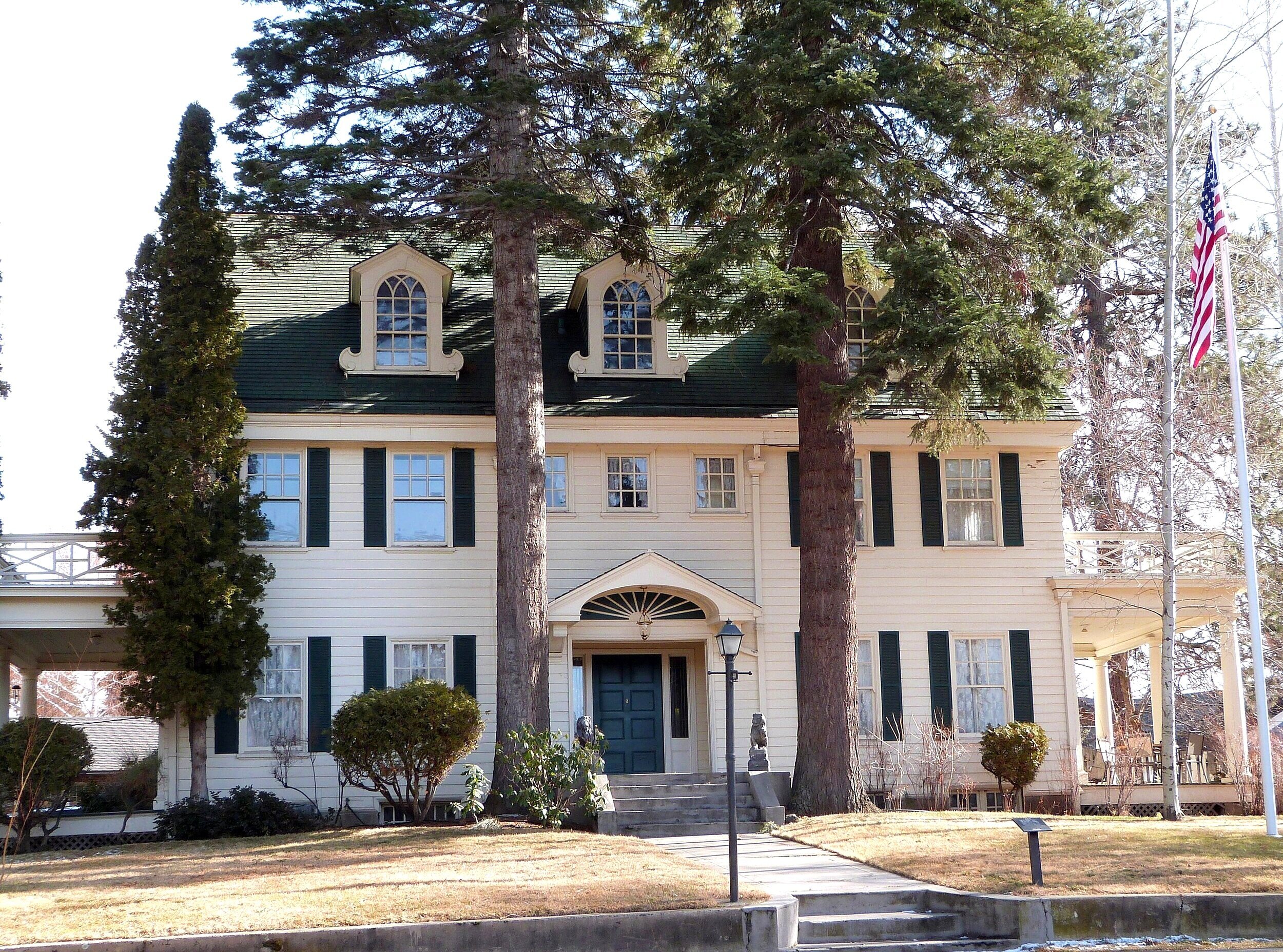Project Spotlight: Historic Renovation- McCann House (A History)
It’s not often that a project comes our way with such historical heart and community interest. We thought we’d dedicate a blog or two to the Historic McCann Mansion restoration. This home strikes a nostalgic and emotional chord for many-a-Bendite and just as many would love to know what the owners have planned, and a sneak peak into the process. We promise to dedicate another post to the current happenings and process behind design decisions, but we thought that a thorough summary of the history of this iconic house might tickle the fancy of all you history buffs out there.
The Thomas McCann House was built in 1915 by the Shevlin-Hixon Lumber Company for Thomas McCann, the vice president and general manager of its Bend mill. At the time, Bend was fighting for its economic survival and the Shevlin-Hixon and Brooks Scanlon mills provided job security to their workers and economic stability to the region. Thomas McCann, the son of Mary Shevlin McCann, grew up working in the family lumbering operations in Minnesota where the large, parent company was based. In the family’s initial forays out west they based themselves in Portland where they met many prominent members of the community, including architect David C. Lewis.
Thomas McCann commissioned David Chambers Lewis to design his new home in Bend, OR. This would have been a rare occurrence in those days as Bend was a small pioneering town and the homesite was merely a rise between ponderosa pines and juniper trees not far from the Deschutes River. The house was to be set on three large lots, which were later increased to four. Historians have noted that the McCann House seems to share many similar design elements as David C. Lewis’ father’s house, the Cicero H. Lewis residence, in Portland. The configuration of the front entry and stairs resemble his father’s home, and many exterior and interior elements are additionally reminiscent of his own home in Portland, which can still be visited today.
David C. Lewis was an outstanding architect of the day. He was educated at Princeton and Columbia Universities and had already made a name for himself by the time he was asked to design the European Building at the Lewis and Clark Exposition in 1905. He was subsequently commissioned to create the “Oregon Building” at the Alaska-Yukon-Pacific Exposition in Seattle in 1909. He also designed the Trinity Episcopal Church in Portland, the Railway Exchange Building (a National Historic Register Building), his brother’s home, the L. Allen Lewis residence (a Portland landmark), and several other prominent residences and public buildings throughout the Portland area.
Although there were four general managers during Shevlin-Hixon Lumber Company’s tenure in Bend, Thomas McCann and his family were the first residents from 1916-1921 and many of the home’s features were designed with this first family in mind. The McCanns had small children so a nursery adjoining the master bedroom was necessary. As the McCanns employed live-in servants, the third floor, with its iconic dormer windows, was reserved for their quarters. The servants also made use of many other interesting features, some that still exist in the home today- a set of back stairs that runs from the third floor to the basement, a bell-summoning system, a back service hall, two pantries in the kitchen area, a (rare at the time) central vacuum system, and a woodbox with a false bottom to allow for firewood to be brought up from the basement to upstairs rooms. There are three fireplaces (still) in the house- two downstairs and one in the master bedroom. When the home was built the original source of heating fuel was sawdust delivered by horse-drawn wagon from the mill. It was dumped into an outside box, went down a chute, and onto a conveyor belt that fed the furnace. I can almost imagine those millworkers lucky (or unlucky) enough to draw the straw of having to drive the wagon over to the McCann place on frigid Bend mornings to dump the sawdust in the bin for the servants to light Mr. McCann’s fires. Interestingly, when Copperline began the work of renovating the home, in between the layers of lathe and plaster in the walls, century-old sawdust was found as insulation, but that’s a story for another blog.
When the McCann Mansion was added to the National Register of Historic Places in 1980 (since removed), then owners, Roger and Sharron Comeau, gave a beautiful description of the home at that time. We are including this description from the original nomination form for all of you architecture nuts out there:
The Thomas McCann House is a 5,500 square foot Georgian Revival (aka Colonial Revival)-style residence. It was designed by David Lewis, a prominent Portland architect, in 1915. It is in very good condition and is still in use as a residence.
The house, oriented to the west, was originally sited among mature pine and juniper trees overlooking the Deschutes River. It occupies Lots 1 through 4 of Block 12 of the Park Addition, City of Bend. The house comprises two-and-one-half stories plus a full basement. The concrete foundation supports balloon-framed wall construction which is covered with clapboard siding. The cedar shingled gable roof is interrupted by three oversized-pedimented dormers with shingled checks on the west elevation and several shed dormers on the east elevation. Most windows are simply framed multi-over-one sash and have shutters.
The west elevation is characterized by a formal simplicity. Divided into three bays, the facade is framed by open, columned porches on the sides. Both of the flat upper decks are surrounded by Chippendale-style railings. The recessed entry is simply covered by a consoled gabled roof. An elliptical opening in the gable is mirrored by an elliptical wooden fan over the entry. The massive paneled door is bordered by side lights but no transom. Three small casement windows above the entry lead to the upper stair hall. Sets of single windows are disposed on either side of the central bay. The composition is completed by the pedimented dormers, each of which contain traceried, round-headed lights and scroll moldings.
The other elevations are characterized by asymmetrical placement of windows which reflect the interior functional arrangement. Of particular interest on the east (rear) elevation is the palladian window which leads to a landing stairway.
The interior plan is characteristic of the Georgian style, with rooms being placed around a large entry and central, open stairwell. The main living room is on the right of the hall and the formal dining room is on the left.
The living room is detailed with a painted wainscot and ceiling moldings made of plaster. Both the living room and the dining room open directly onto an exterior porch area. The library sits to the right of the stair and carries its own expression derived from the rather heavy wood coffered ceiling and handsome fireplace. the main level floor surface is distinctive in being constructed from narrow maple slats less than 1” in width. The upper level sleeping rooms again are symmetrically placed around the stairwell. This level consists of a master bedroom with an adjacent nursery on one side and a sleeping porch and bedroom on the other. The sleeping porch faces out onto the east yard and is enclosed with a continuous row of windows that pivot about their centers, allowing for maximum ventilation.
The attic is a generous space with light admitted by the three large dormers with their beautiful rounded top windows. The decorative detailing on the exterior of the dormer windows are indeed a trademark of Mr. Lewis. The building is very close to its original design and shows no sign of structural or material deficiency. -Sharron and Roger Comeau
Fifty years after the description above was written, Copperline continues to work to restore the McCann Mansion for its current owners. Stay tuned for updated pictures and posts!
This post draws its information from the National Register of Historic Places Inventory. The McCann House is part of the Drake Park Neighborhood Historic District.

